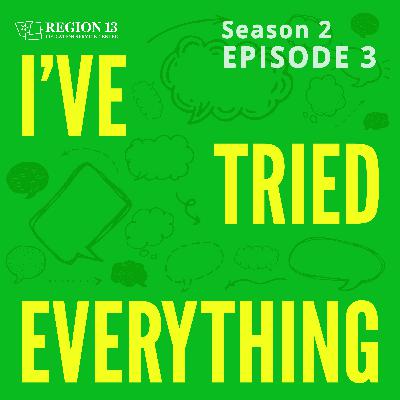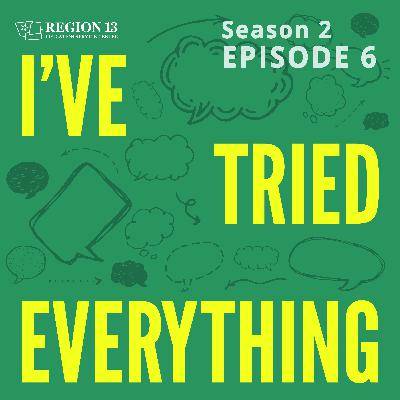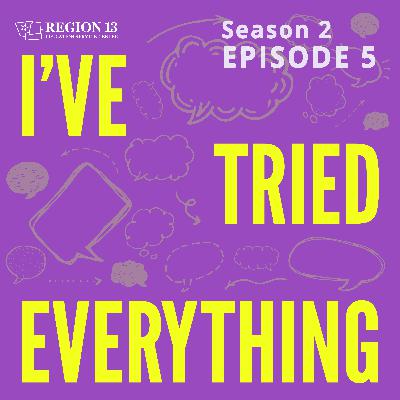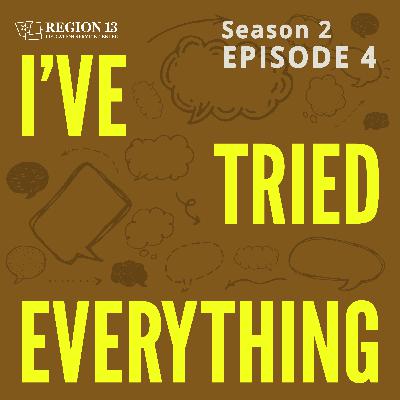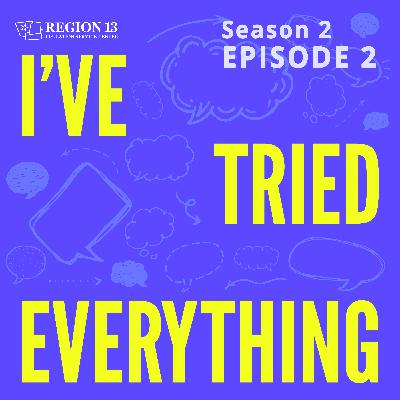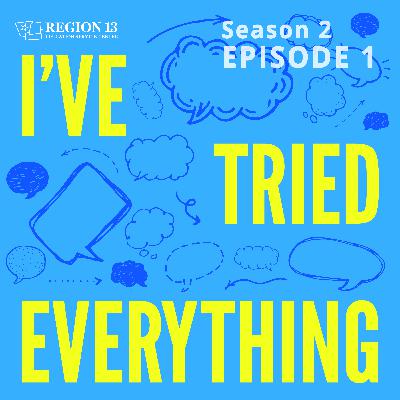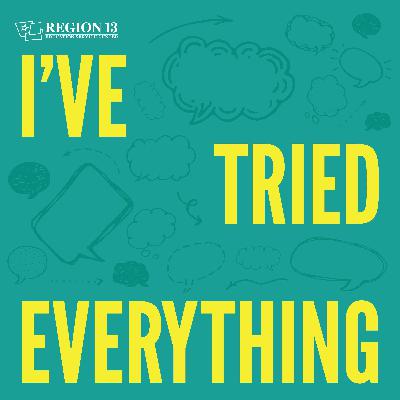S2-Ep3 - Academics And Behavior Go Hand In Hand
Description
Angela:
Hello, welcome back to I've Tried Everything, a podcast focusing on behavior supports in schools. I'm your host, Angela Isenberg, project coordinator at Region 13. Every week I talk with educators just like you. We cover some tough topics, share stories, and explore what works and what doesn't. Let's go. I am absolutely honored to be joined by my Deputy Executive Director of Academic Services. That is a huge mouthful, Kerry?
Kerry:
Yes, long title.
Angela:
I also want to say happy one year anniversary of being at Region 13. We always tease Kerry because she worked at Region 10. So I think we're all going to start making her pay some money now that she's been here for a year.
Kerry:
Yes. Anytime I say it on accident. Yes.
Angela:
So welcome, Kerry. I'm glad that we've had you for a year. I'm thrilled. You're really the lead person for academics in our region. You put really great stuff out there for our clients and for our academic leads in Districts. So on our team for behavior here at the service center, we talk a lot about that you can't separate academics and behavior. They really go hand in hand. So when we are meeting about a student's academic success, we have to talk about behavior as well. How do you see the two working together collaboratively in order for there to be success for students and staff on campuses?
Kerry:
So what I would say to that is, I agree a hundred percent. Academics and behavior go hand in hand. This is my 26th year in education. So I was here when No Child Left Behind passed, and I saw all of the changes that came with that as far as giving students who have different needs full and complete access to the general curriculum. And I am a huge philosophical believer in that is the way we make sure every kid gets what they need is that full access to the general curriculum.
So the way academics and behavior go hand to hand is we have to build situations, opportunities, training, leadership, support, so that teachers have the skill sets they need in both academics and behavior management. So way back when, when I started teaching in 1997, you went into a classroom and you were trained up really strongly in instructional pedagogy, in your content area and all those things. Your support, your training in the area of how to help manage behavior of students with different needs was nonexistent.
Angela:
This is so true.
Kerry:
It was so true. Right?
Angela:
Same ballgame for me too.
Kerry:
Yes. And so then as we've progressed and things like No Child Left Behind, people love it, people hate it, but it did insist that we make sure every single kid gets access to that general curriculum. So as we've progressed, what I've seen change and then thus the need for academics and behavior to go hand in hand is we have to change the mindset of how we prepare our teachers. It's no longer just instructional pedagogy and academic content, but it is also how do you manage the people in the room.
Teaching is more than just standing up and delivering a message about English literature, how to do an algebraic equation, but it's managing the people in the room. And whether you have 22 first graders or 38 English Four kids, your job is to create an environment where all the students, all the people in that room get access to that great academic content that you can offer. So you've got to have the skill set of managing the people.
And to be quite honest, in our world now, managing the people means understanding behavior management of all kids. Not just the kids who come in with your traditional, they don't have different needs, they're just a run of the mill kid. But you've also got students who are dealing with mental health issues and students with cognitive disabilities and all sorts of things that make their behavior needs different. Our teachers have to be prepared to be able to manage that because the point is to deliver that academic content every single one of the people in that room. So to manage those people.
Angela:
Same ballgame for me for my college curriculum. I'm very excited, my daughter is going to college to be an elementary educator.
Kerry:
Oh, yay.
Angela:
So I'm thrilled to see how much behavior is embedded into her content. And it's really fun for us to have conversations about, "Mom, today, like we talked about social-emotional learning or we talked about restorative practices," and I'm like, "Oh, I'm so excited, I'm thrilled." And then of course she thinks I'm some kind of famous person because she's like, "Mom, I dropped your name today in class." I'm like, "I don't think most people in San Angelo, Texas know who I am."
Kerry:
That's awesome. Well, I'm a field supervisor for one of our interns in our Educator Certification Program this year. It's one way I'm trying to stay connected to what's happening in schools and I'm seeing the same thing. Our ECP program is really preparing these interns to do both, the delivery of the academic content and the management of the behavior. And in fact, when I go out and observe in my intern's classroom, the majority of our conversations are about behavior management. She's got the academic content. It's that behavior management that she's learning.
Angela:
So you have the pulse of curriculum directors across our Region. You do a Curriculum Council C2 once a month. One of the messages that I think you've gotten from some directors out there is that some behavior might be impeding academics. What behavior challenges right now are folks telling you that they're facing in their Districts?
Kerry:
So it's multifaceted. Right now, this teacher shortage is so real. And what I hear more than anything is that Districts are struggling to keep teachers in those behavior classrooms, those very specific settings that are unique. But they're also struggling to keep teachers in the general ed classrooms because, again, teachers who are unequipped to deal with some of the behavior management are struggling. And in extreme cases, the teachers themselves feel like they're in danger. I tend to be one of those people who believe the kid is not dangerous. It's the situation where the person is not trained to deal with the behaviors that makes it dangerous. But that's probably the biggest thing that curriculum directors are facing is just keeping the professionals in the room.
I said it's multifaceted because then once you've got the professionals in the room, we're in a world where Star is very important, where accountability is very important, where catching kids up from the learning loss of COVID is incredibly important. So curriculum directors feel an unbelievable pressure to make sure that a certain number of standards are covered, that a certain number of standards are mastered. They find it difficult to manage the balance of training for teachers. All that heavy academics is where we are all trained as curriculum directors to go, but they have to stop and realize that that behavior management, you can't get to the academics if the behavior's not managed.
So that's something I hear too is how do we balance. We only get five PD days a year. We only have so many hours to give teachers professional development. How do we balance getting all the academics pushed out and also give them the training that they need on behavior, restorative practice, responsive learning, all those things. So that's a struggle too. And so a lot of what I've actually talked to curriculum directors a lot about recently is some unique ways to build a professional development schedule that'll allow you to strike that balance. Because if I go back to what I said earlier, a lot of teaching is training teachers how to manage the people in the room. It's very important. You can't give it up for the academics. It's finding that balance.
Angela:
One of the things that I try to push out there when I'm working with schools and the whole school framework of behavior supports, it is how do you embed this learning into everything that you're doing? Because if you just do a one shot workshop in August when teachers aren't necessarily paying full attention because they're worried about their classroom and getting it set up and first day of school and all those kinds of things, you're missing the ballgame. It's like how do you take all of that greatness and push it all together in a way that's blended?
The other thing that I want people to really think about that's pushing out curriculum and professional development is that we have to differentiate for our professional development. And putting this one-size-fits-all, where we're all in the cafeteria together and we're all getting it at this. So how do you differentiate for your brand-new teachers that don't know versus your veteran, 20-year teachers that have a lot of the key pieces, they just might need to hone in on how to make their craft better. Right?
Kerry:
Yes, exactly.
Angela:
So that teacher shortage is real. And we know that behavior is one of the top reasons why, but also the amount of just overwhelming stuff. If you had some kind of magic wand, I know, and that'd be wonderful if you did, if you had some kind of magic wand that would say, "These are a couple of the things to address the teacher shortage," what would you say? What would you recommend?
Kerry:
I am a big fan of autonomy with coaching. And so I think that in a lot of cases we dictate too much what can and can't happen in those classrooms. We're trying to script too much what can and can't, which doesn't allow room then for the modifying, the accommodating, management of behaviors. Even modifying and accommodating academic need. "I'm on a scope and sequence, I have to get going. I can't stop and wait for this

